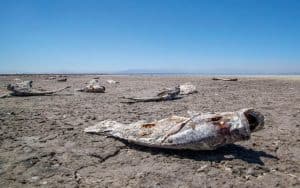
As the world transitions away from fossil fuels, electric vehicles are becoming more ubiquitous. But despite their environmental benefits, they still have a price. The batteries that power them rely on a limited resource: lithium.
But some say California’s so-called “Lithium Valley” could be a vast powerhouse for the next century’s battery needs. A team of scientists is planning to map out deep-earth lithium to see if it can sustainably supply America’s insatiable demand for the element.
The challenge: As electronic devices and electric vehicles become more widespread and our appetite for lithium grows, a lithium supply crunch looms. Just last year, the price of lithium jumped by more than 400%.
By 2030, Cadillac says they will only offer an all-electric lineup of vehicles. GM pledges to go all electric by 2035, and Honda plans to phase out all gas cars by 2040. As more car manufacturers aim to switch to all EV inventories in the next decade, where will they get all that lithium?
Recycling batteries is making some progress. But it isn’t efficient enough to solve our supply needs. And even though researchers are close to finding alternatives to lithium batteries — like 3D-printed solid-state batteries, batteries made from trees or with kevlar membranes, and flow batteries — nothing available today matches the efficiency of lithium.
The promise: The Salton Sea is a land-locked salt lake in the California desert. As odd as it sounds, the salty, superheated water reservoir below the surface promises to provide an abundance of geothermal energy. This renewable energy is produced when hot fluids are brought up from deep down, and the heat is converted to electricity.
Currently, 11 commercial facilities are producing energy in the Salton Sea geothermal field. Once the fluid is cooled, it is typically returned to its origins deep underground. But many scientists hope to get an energy two-for-one — by extracting lithium from it first.
The deep-earth chemicals beneath the Salton Sea could contain enough lithium to cover all of America’s domestic battery demands. But only if it can be sustainably purified and extracted — a process that isn’t nearly as easy as lithium mining.
But as it is currently done in China and Australia, mining lithium from open pits can pollute the air and groundwater and deplete water resources. And even with other extraction options, current mining techniques can’t keep up with the demand.
“The Salton Sea geothermal system is the primary potential geothermal resource for lithium in the United States, and it’s a world-class resource,” said Berkeley Lab’s Pat Dobson. “But there is a wide range of estimates in terms of the size of the resource, and also not a great understanding of where the lithium comes from.”
Mapping the solution: A collaboration of scientists led by Lawrence Berkeley National Laboratory plans to map the source, extent, and long-term viability of the lithium that can be extracted from the geothermal brines of the Salton Sea.
“This work is important to me [because] domestic lithium extraction and lithium battery production provides a means to make our transportation and electrical grids renewable and green. Right now the U.S. imports almost all of its lithium and lithium batteries, with a high carbon footprint for shipping them from Asia,” UC Riverside geochemist Michael McKibben told Freethink, adding that, “The County of Imperial is impoverished so the development of lithium extraction from the geothermal brines there, coupled with the possibility of locating battery manufacturing facilities nearby, could provide a tremendous economic boon to the needy communities.”
One of the aims is to find out how quickly the lithium would be depleted — or, if it is continuously replenished, where it comes from. The team plans to use energy-dispersive and laser ablation instruments, which use lasers to perform chemical analysis.
By knowing exactly where the lithium is and in what form, they can calculate how much we have to work with. Their initial estimates imply there could be millions of tons of lithium hiding there.
“That would be the largest brine source of lithium in the world, bigger than any individual South American salar deposit,” McKibben told Mining.Com. “So, it’s a big number, and it means the potential is there for – again, back-of-the-envelope calculations – something like 50 to 100 years’ worth of lithium production.”
